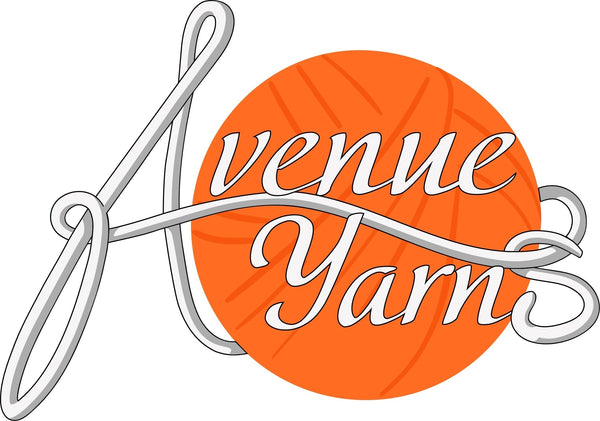How is your Summer Knit Along project going? We are all loving the extra texture of the single row stripes in luscious, variegated yarns. Send us a WIP photos! Or post one on Instagram, tagging Avenue Yarns.
Over the next few weeks, I’ll post a couple of little tutorials for knitting single row stripes. Full disclosure? I planned to have these all up and posted by now. But techniques like helical stripes are new to me. And I need a better handle on the new technique before I am able to write let alone teach about it.
I have a couple of patterns in the works too, for those of you who want easy practice in single row stripes before taking on a bigger project, like Joji’s Boxy po.
But for now, here’s a mini tutorial on single row stripes knitted flat. This technique is best for shawls and scarves, and anything you might seam to finish. It’s a super easy technique and produces a very interesting fabric.

For this swatch, I’m working on size 6 double pointed needles with two colors of Brooklyn Tweed Arbor, one in Sea glass, and the other in Treehouse (this combo of names has me up on the NorCal coast…). The double pointed needles are essential to this technique.
I’ve cast on 30 stitches and knitted 6 rows of garter stitch for the bottom edging. For the rest of the swatch, I’ll be knitting 3-stitch garter side selvedges to keep the piece from curling. Garter in these single row stripes ends up knitting columns of unusual—and charming— selvedges. It still works to stabilize the swatch. And look at the photo on Instagram for a couple of images of the interesting selvedge pattern this switcheroo makes!

So, after knitting the bottom main color (MC) garter selvedge, join the contrast color (CC), and knit one row.

Then instead of turning the work and purling, slide the work back to the other needle points and the MC working strand, and knit across with the MC. Now both the MC and CC strands are on the same side.

Now it’s time to turn your work. Purl across with the CC yarn, remembering to knit the KKPP side selvedges. Then slide your work back to the working strand of MC, and (with selvedges) purl across. And keep on going.
There is something about this technique that reminds me of the old children’s game, Red Rover. Red Rover, Red Rover, send MC on over! Red Rover, Red Rover, send CC on over! I find it to be almost as fun as that game.
So what do you do if you have to put your work down and get on with – Oh, maybe drafting important legislation, or being an ally and advocate to those who need one? Just look at your work to see which color comes next, and where you are in the pattern. If both colors are on the same side, you’re ready to turn the work. If the colors are on opposite sides, finish up with either a purl side or a knit side in the color that’s ready to be worked. It’s easy to pick your knitting up and go with this technique.
A few notes about the swatch here. To help me remember which size needles I knit with, I put a row of 6 eyelets (*YO, K2Tog* 6 times) in the upper right corner, just before knitting the MC garter selvedge for the top.

And there’s the matter of the little slub that is there in the fabric like a long leg. There was a wee flaw in the spinning, where for half an inch, the ply was loose and fluffy rather than Arbor's normally tight twist. To be honest, I appreciate wee things like that. It is a small, interesting reminder of the craft I am always learning.

I hope you enjoy this technique. And remember to show off your colors!
Carri-Lu

0 comments